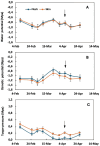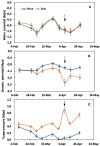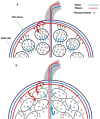Unraveling water relations in growing fruit: insights from the epidermal growth regulation hypothesis
- PMID: 39735777
- PMCID: PMC11671803
- DOI: 10.3389/fpls.2024.1495916
Unraveling water relations in growing fruit: insights from the epidermal growth regulation hypothesis
Abstract
This review focuses on the intricate water relationships between internal and external tissues in growing fruits within the framework of the epidermal growth control hypothesis. It considers the components of water potential, including turgor pressure and osmotic potential of both internal and external tissues, taking into account factors such as fruit growth rate, sugar accumulation, cell wall metabolism, and climacteric. It also examines the effects of environmental conditions, genetic factors, and physiological influences in modifying water relations. By emphasizing the significance of skin tissue water potential components as indicators of growth stress, the review underlines their importance for a comprehensive understanding of water relations and associated physiological disorders in growing fruit.
Keywords: environmental factors; fruit cracking; fruit growth; osmotic potential; physiological disorders; purple spot; skin tissue; turgor pressure.
Copyright © 2024 Gariglio, Reig and Agustí.
Conflict of interest statement
The authors declare that the research was conducted in the absence of any commercial or financial relationships that could be construed as a potential conflict of interest.
Figures




References
-
- Agustí M., Mesejo C., Reig C., Martínez-Fuentes A. (2014). “Citrus production,” in Horticulture: Plants for people and places, vol. 1 . Eds. Dixon G. R., Aldous D. E. (Springer, Dordrecht, NL: ), 159–195.
-
- Araújo-Ferreira R., Mendes-Aroucha E. M., Alves de Paiva C., de Medeiros J. F., Pereira-Barreto F. (2016). Influence of the main stem pruning and fruit thinning on quality of melon. Rev. Ceres 63, 789–795. doi: 10.1590/0034-737X201663060007 - DOI
-
- Bacon M. A., Thompson D. S., Davies W. J. (1997). Can cell wall peroxidase activity explain the leaf growth response of Lolium temulentum L. during drought? J. Exp. Bot. 48, 2075–2085. doi: 10.1093/jxb/48.12.2075 - DOI
Publication types
LinkOut - more resources
Full Text Sources

